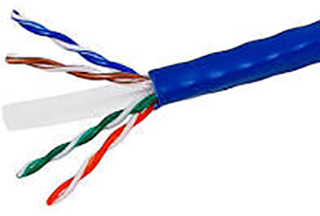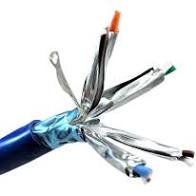Categorized cable, commonly known as Ethernet or LAN cable, is the industry standard for building a structured cabling system that enhances voice and data network performance, whether for small or large businesses.
Ethernet cables consist of four Unshielded Twisted Pair (UTP) copper wires and are classified into subcategories based on performance; such as Cat5, Cat5e, and Cat6e. The performance of these cables is defined by their bandwidth and data transfer speeds. However, signal quality degrades over long distances, which is why the maximum cable length is limited to 100 meters. Thanks to the consistent twisted-pair design across categories, these cables are backward compatible, though the lowest-performing cable in use will dictate overall network speed.
Structured cabling follows the TIA/EIA-568 A and B telecommunication standards, ensuring best practices in design and installation for voice, video, and data networks, delivering reliable performance across systems.
Interested in upgrading your network? Contact our structured cabling professionals for expert network cabling help.
Category 5 cable also called Cat5 is a cable typically used for home or small businesses. At a frequency of 100 MHz, Cat 5 transfers data between 10 to 100 Mbps and is suitable for most basic internet, phone and video structured cable designs while also being the most cost efficient. This cable is no longer in use.

Cat5e or Enhanced Category 5 is the upgraded version of Cat5. Both Cat5 and Cat5e transmits at a bandwidth of 100 MHz, but whereas Cat5 can transfer data at speeds up to 100 Mbps, Cat5e can transmit at 1000 Mbps.
Cat6 is the step up from Cat5e. It has a bandwidth of 550 MHz and data speeds of 1000 Mbps, but those speeds can be improved to 10 Gbps if length is reduced to 55 meters from 100 meters. While the main difference between Cat6 and Cat5e is the bandwidth, Cat6 has a lower crosstalk (signal interference) and less signal loss using a tighter cable twist.

Augmented Category 6 or Cat6a is the upgraded version of Cat6 and is capable of transfer speeds of 10 Gbps at 100 meters, unlike its predecessor Cat6. A bigger advancement is that Cat 6a has double the bandwidth from 250 to 550 MHZ. Also, Cat6a commonly comes with extra fortification using Shielded Twisted Pair (STP) that has better protection against crosstalk and other interference.
| CATEGORY | BANDWIDTH | DATA TRANSFER RATE |
| Cat 5 | 100MHz | 10-100 Mb/s |
| Cat 5e | 100MHz | 1000 Mb/s |
| Cat 6e | 550MHz | 1000 Mb/s (10 Gb/s possible to 55 meters) |
| Cat 6a | 550MHz | 10 Gb/s |
Confused about which Categorized cabling is best for your business needs? Let us help make the best structured cabling decision for you.
When building or upgrading a small business network, the type of structured cabling you choose has a big impact on speed, reliability, and long-term performance. Two of the most common options are Cat5e and Cat6e network cables. Both are widely used in offices, but which is best for your business?
If your business has standard networking needs—like email, point-of-sale systems, and light internet usage—Cat5e cabling is usually sufficient and budget-friendly. However, if your company depends on high-speed internet, remote collaboration tools, or plans to expand, Cat6e/a cabling is a smart investment that ensures better performance and scalability.
At Acme Telephone Co., we provide professional structured cabling installations using Cat5e, Cat6e, and fiber optic solutions. All of our data cabling is tested and certified to industry standards, giving your business a reliable foundation for communications and growth.
Looking to upgrade your small business network? Whether you need Cat5e, Cat6e/a, or fiber optic cabling, our experts can design and install a system tailored to your needs.
 Call Acme Telephone Co. today for a free consultation and quote on business network cabling in Kitchener, Waterloo, Cambridge, Guelph, Hamilton, and London.
Call Acme Telephone Co. today for a free consultation and quote on business network cabling in Kitchener, Waterloo, Cambridge, Guelph, Hamilton, and London.